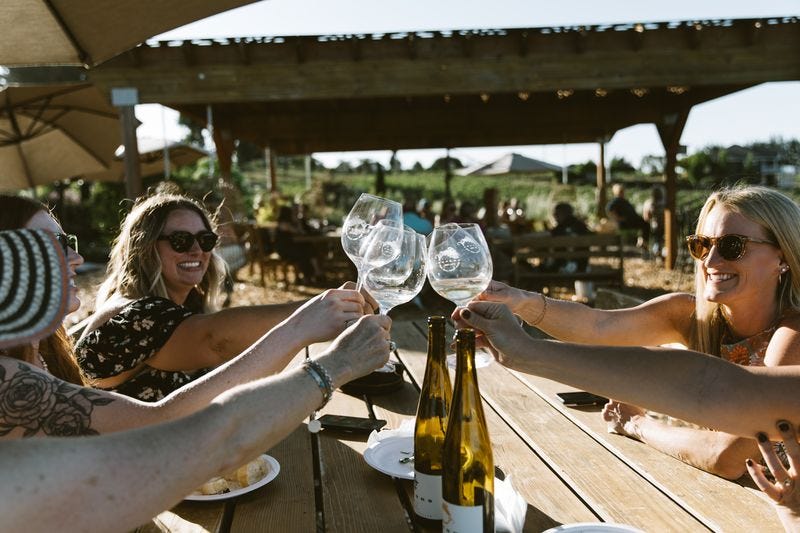Small wineries unite!
EXCLUSIVE: Innovative wine club collaboration gives consumers wider access
Joining a wine club is no longer just a way to get discounts and special access at your favorite winery: Under a new consortium being announced today, club membership can be your passport to delicious wine experiences around the country.
The Wine Atlas Collective is akin to the Star Alliance and other airline groups in which frequent flyers enjoy reciprocity benefits with other member airlines. With the Wine Atlas Collective, consumers who belong to a participating winery’s club will be treated like a club member when visiting another participant winery. Additional benefits, such as club member discounts on direct shipping, will be added in the fall.
The collective is the brainchild of Janie Brooks Heuck, managing director of Brooks winery in Oregon’s Willamette Valley, and Jen Cossey, the winery’s general manager, who were spitballing ideas to increase club membership and their direct-to-consumer business during the current market downturn for wine.
The new Wine Atlas Collective is a national network of independent, sustainable wineries providing reciprocity benefits to each other’s members.
“We were trying to come up with better benefits for wine club members who don’t live in-state, because they can’t come here and take advantage of a free tasting or a launch party,” Heuck said in an interview. Cossey then suggested it would be nice if Brooks club members could go to a local winery near where they live and be treated like a club member, and the idea grew from there.
The new collective is “a national network of independent, sustainable wineries providing reciprocity benefits to each other’s members,” Heuck explained. Seven of the founding wineries are family owned, while Ridge Vineyards, the largest and probably best known, is owned by a Japanese company but run by the same team for decades.

This collaboration can help small wineries squeezed by increasing consolidation among wholesalers, a drop in winery tourism and a broader market downturn. They will help increase awareness of their wines and give members of other participating wineries an incentive to visit when traveling in their own regions.
“Membership is an acknowledgment of our winery’s commitment to the principals of environmental stewardship and community support, and a little respectful nod from our peers for our devotion to hand crafting wines that are transparent and true to this place we call home,” said Nancy Irelan, owner and winemaker of Red Tail Ridge, a sparkling wine specialist in the Finger Lakes. “The collective is a vehicle for celebrating the diversity of our domestic wine communities within a collaborative framework.”
Ben Dimitri, marketing manager for L’Ecole No. 41 in Washington state, said his members “gain access to a wider, curated selection of diverse wines from various regions, experience the convenience of streamlined discovery, and often receive exclusive access to member-only wines.” (He’s the marketing guy, remember.) “For L’Ecole, it means expanding our market reach to new customers across the USA, enhancing brand visibility by being featured alongside other esteemed wineries, and driving direct-to-consumer sales.”
For Jason Haas, partner and general manager of Tablas Creek Vineyard, the collective “will hopefully introduce Tablas Creek to thousands of potential customers who have never had a chance to visit us or maybe even visit Paso Robles,” while “reinforcing the value of membership to our existing customers. It seems like a win-win for everyone.”
The founding eight wineries work with 43 different grape varieties, so the collective aims to give a broad glimpse of American wine. And they start with nearly 46,000 members all told.
Here are the eight founding wineries, their locations and their main grape varieties, with links to their websites.
Blenheim Vineyards: Monticello, Charlottesville, Virginia. Albariño, Chardonnay, Grüner Veltliner, Cabernet Franc, Merlot.
Brooks: Willamette Valley, Oregon. Riesling, Pinot Noir, Gewürtztraminer, Pinot Blanc, Gamay, Syrah.
Frog’s Leap: Rutherford, Napa Valley, California. Chardonnay, Sauvignon Blanc, Cabernet Sauvignon, Zinfandel.
L’Ecole No. 41: Walla Walla, Woodinville, Washington. Chardonnay, Chenin Blanc, Semillon, Sauvignon Blanc, Cabernet Sauvignon, Merlot, Syrah.
Red Tail Ridge: Seneca Lake, Finger Lakes, New York. Riesling, Chardonnay, Blaufränkisch, Cabernet Franc, Dornfelder, Lagrein, Pinot Noir, Teroldego.
Ridge: Sonoma County, Santa Cruz, Paso Robles, California: Cabernet Sauvignon, Rhone Varieties, Zinfandel.
Tablas Creek: Paso Robles, California: Rhone varieties - the familiar and the obscure.
William Chris: Texas Hill Country, Texas. Mourvedre and other Rhone varieties.
As of July 1, any member of one of these winery’s clubs who visits another participating winery will be treated as if they were members there. That is, if you’re a member of Blenheim’s club and you visit one of Ridge’s locations, you can enjoy whatever experience Ridge offers its members. Heuck says they hope to add an e-commerce feature in the fall, and she’s exploring various potential commercial tie-ins.
More information will be available on the collective’s website, www.wineatlascollective.com, and on social media @wine_atlas_collective.
Editorial comment: I think this is a terrific idea, and I hope it works. We hear a lot from winemakers that “our farms are ecosystems,” which always seemed to me a somewhat insular perspective. And we all know winemakers who love making wine but hate selling it. This could be a great way for these wineries to leverage each other’s reputations and memberships to increase their own audiences. And it’s an added benefit of club membership for consumers who live out of state and can’t always visit their favorite wineries.



These wineries sound amazing!!
This is a fantastic idea. Particularly excited given several of these places I’ve followed closely for quite a few years but haven’t been able to justify individual memberships to.
Here’s hoping that the wineries will maintain accessible individual memberships as well and that they are willing to invest in the partnerships beyond the inevitable mismatches between demand and supply common for the initial years of partnerships like this.